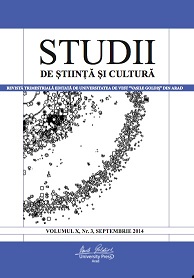Limbajul publicităţii pentru comerţul cu robi, în Ţările Române
Language of Slavery trade advertising in the Romanian Principalities
Author(s): Marian PetcuSubject(s): Literary Texts
Published by: Editura Universităţii Vasile Goldiş
Keywords: language, advertising, slaves, Gypsies, langage, publicité, esclaves, gitans, limbaj, publicitate, robi, ţigani
Summary/Abstract: It has been written and discussed about the Gypsies plenty of times after 1989, but several issues have been left untouched by the researchers. For instance, the slave trade or, to be more speficic, the advertising used for this trading type, the transaction’s arrangements, the prices, the employment areas where Gypsies could be found etc. I sought to clarify in this study how does this type of trade show itself in our press during 1837-1850. The Gypsies were documentary certified on the actual territory of Romania at 1385, being the subject thorough the legal settlements established once with the Organic Statuses (1831), the documents that foresaw the disposal of nomadism, the allocation of land parcels per family and so on. In fact, the authorities’ purpose was their division and uptake. After 1830, the Gypsies topics were intensified – see Ion Câmpineanu’s attempt to free the inherited slaves, then several acts of gradually freedom brought to the various categories of slaves. In Moldavia, for example, during January- February of 1844, royal servants or the ones from monasteries were freed. On the eve of the 1848 Revolution, the servants of the monastic establishments from Wallachia were also released. However, this state of freedom caused by the change of the 1848 political system does not last long enough, especially after the revolution’s suppress and the restitution of the old regulations. This is how in October 1856 slavery is abolished by law in Moldavia, every slave owner being indemnified by the State, for four to eight ducats per slave. In Wallachia slavery is abolished on the day of February 20th 1856, the indemnifications meaning 10 ducats per slave. Please note that not the slaves were indemnified, but their owners! Moreover, once with the free citizens statuses, the Gypsies were obliged to pay taxes. The question is: who would have been dealing this type of trade? The slave owners – the Church, the landowners, the State behind its institutions, and the press offices of newspapers which often had the role of intermediaries. Possessing Gypsies meant possessing power.
Journal: Studii de Ştiinţă şi Cultură
- Issue Year: X/2014
- Issue No: 03
- Page Range: 228-232
- Page Count: 8
- Language: English

